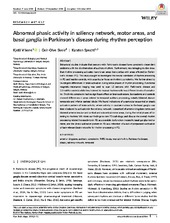| dc.contributor.author | Vikene, Kjetil | |
| dc.contributor.author | Skeie, Geir Olve | |
| dc.contributor.author | Specht, Karsten | |
| dc.date.accessioned | 2020-07-01T11:11:52Z | |
| dc.date.available | 2020-07-01T11:11:52Z | |
| dc.date.issued | 2019 | |
| dc.Published | Vikene K, Skeie GO, Specht K. Abnormal phasic activity in saliency network, motor areas, and basal ganglia in Parkinson's disease during rhythm perception. Human Brain Mapping. 2019;40(3):916-927 | eng |
| dc.identifier.issn | 1065-9471 | |
| dc.identifier.issn | 1097-0193 | |
| dc.identifier.uri | https://hdl.handle.net/1956/23164 | |
| dc.description.abstract | Behavioral studies indicate that persons with Parkinson's disease have complexity dependent problems with the discrimination of auditory rhythms. Furthermore, neuroimaging studies show that rhythm processing activates many brain areas that overlap with areas affected by Parkinson's disease (PD). This study sought to investigate the neural correlates of rhythm processing in PD and healthy controls, with a particular focus on rhythmic complexity. We further aimed to investigate differences in brain activation during initial phases of rhythm processing. Functional magnetic resonance imaging was used to scan 15 persons with Parkinson's disease and 15 healthy controls while they listened to musical rhythms with two different levels of complexity. Rhythmic complexity had no significant effect on brain activations, but patients and controls showed differences in areas related to temporal auditory processing, notably bilateral planum temporale and inferior parietal lobule. We found indications of a particular sequential or phasic activation pattern of brain activity, where activity in caudate nucleus in the basal ganglia was time‐displaced by activation in the saliency network—comprised of anterior cingulate cortex and bilateral anterior insula—and cortical and subcortical motor areas, during the initial phases of listening to rhythms. We relate our findings to core PD pathology, and discuss the overall, rhythm processing related hyperactivity in PD as a possible dysfunction in specific basal ganglia mechanisms, and the phasic activation pattern in PD as a reflection of a lack of preparatory activation of task‐relevant brain networks for rhythm processing in PD. | en_US |
| dc.language.iso | eng | eng |
| dc.publisher | Wiley | eng |
| dc.rights | Attribution-NonCommercial-NoDerivs CC BY-NC-ND | eng |
| dc.rights.uri | http://creativecommons.org/licenses/by-nc-nd/4.0/ | eng |
| dc.title | Abnormal phasic activity in saliency network, motor areas, and basal ganglia in Parkinson's disease during rhythm perception | eng |
| dc.type | Peer reviewed | |
| dc.type | Journal article | |
| dc.date.updated | 2019-11-15T09:08:05Z | |
| dc.description.version | publishedVersion | |
| dc.rights.holder | Copyright 2018 The Author(s) | eng |
| dc.identifier.doi | https://doi.org/10.1002/hbm.24421 | |
| dc.identifier.cristin | 1641795 | |
| dc.source.journal | Human Brain Mapping | |

